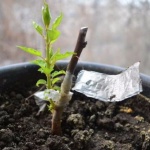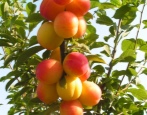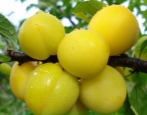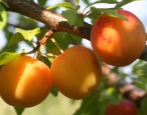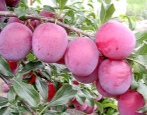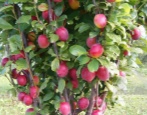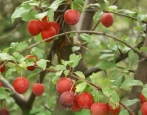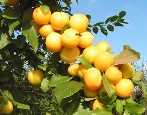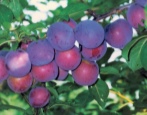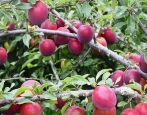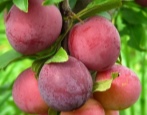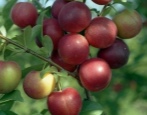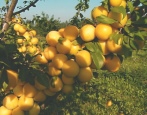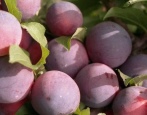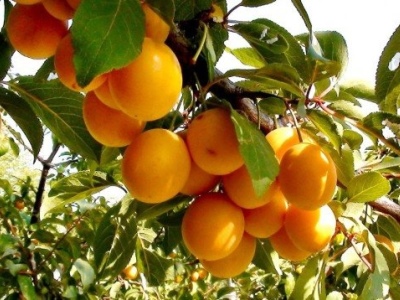
- Authors: V.L. Vitkovsky, G.V. Eremin, Z.M. Gavrilina, O.E. Radchenko
- Appeared when crossing: Chinese plum Early x cherry plum Pionerka
- Year of approval: 1999
- Growth type: medium-sized
- Ripening period: early
- Self-fertility: non-self-fertile
- Yield: high
- Appointment: universal
- Transportability: high
- Fruit weight, g: 10
The fragrant cherry plum fruits are perfect for making jam, compote and other popular treats in Russia. Variety Gift to St. Petersburg - hybrid fruit crop. In the process of breeding it, breeders combined the features of two popular varieties: Skoroplodnaya and Pionerka. On the territory of the country, Gift to St. Petersburg is recommended to be grown in the North-West region.
Description of the variety
Medium-sized trees reach a height of up to three meters. The crown density is average, and it itself is spreading, which must be taken into account when laying a garden. Its shape is cup-shaped. The stem is short. The foliage is ovoid, elongated. Her color is light green. Leaves curved, slightly pointed at the end. The edges are wavy.
During the flowering period, the branches are covered with a large number of snow-white flowers. Due to their high decorative qualities, cherry plum trees are often used as a hedge or decoration. The variety begins to bloom early. This is another characteristic that makes trees highly prized as living decor.
This variety boasts high frost resistance. Lowering the temperature to -30 degrees will not harm the trees, and with the onset of the fruiting period, they will please with a rich harvest. The variety is not self-fertile, so pollinating plants need to be planted nearby.
Fruit characteristics
Small fruits weigh an average of 10 grams each. Their color is yellow, with an orange tint. The shape is elongated, resembling an egg. There are subcutaneous points, they are light yellow. The abdominal suture is almost invisible. The pulp is very juicy, yellow in color, fine fibers are formed inside.
The fruits are covered with a thin and elastic skin. A slight waxy coating is noticeable. The seeds do not detach well from the pulp. The fruits are rich in nutrients. When fully ripe, they begin to crumble.
Taste qualities
The taste characteristics of the crop are at their best. Dessert cherry plum harmoniously combines acidity and sweetness. Professional tasting score - 4.4 points. As it ripens, the delicate fruity aroma intensifies. The amount of dry matter is 15.4%, sugar is 7.2%.
Ripening and fruiting
To harvest the first crop, after planting the trees, you will have to wait 4 years. The variety blooms in May, from 6 to 21, and begins to bear fruit in August, from 8 to 28. Fruiting is noted as regular and stable.
Yield
Due to the high yield from one hectare of the orchard, you can collect 97.6 centners of fruit (average). The Podarok St. Petersburg variety is often grown commercially due to its high transportability.
Growing and care
Each procedure, which is included in agricultural technology, is aimed at the full development of trees and abundant fruiting.
Pruning is an important maintenance condition. Within the boundaries of the regions where frost-resistant varieties are most often grown, they choose a bushy crown shape. Immediately after planting, the skeletal branches are shortened to 50 centimeters.Their maximum number should be 5-6 pieces. After trimming, they are stretched using special braces. In this case, the probability increases that the branches will be completely covered with snow, which will protect them from freezing.
Crown formation takes place during the first 2-3 years, when the tree grows at an accelerated rate. In just one season, the shoots reach the mark of 2-2.5 meters. In June, their length reaches 60-80 centimeters, then they are cut off by 20 centimeters. In place of the lateral buds, new branches are formed on which fruits will grow.
At the beginning of spring, the crown is thinned out so that excessive density does not interfere with fruiting. Get rid of annual shoots. Also, gardeners make sure that the branches do not intertwine with each other. Sanitary pruning is also performed, during which it is necessary to cut out all weakened, damaged and diseased branches.
It is undesirable to carry out the procedure in the fall, as it weakens the trees before the upcoming wintering. All cuts must be covered with garden pitch, otherwise the trees may start to hurt. This composition will protect the cherry plum from precipitation, harmful insects and infections. It also speeds up the regeneration process.
Tree growth slows down immediately after the trees begin to bear fruit and the crown is fully formed. From this period, pruning is performed only for the purpose of thinning the shoots and as a sanitization.
Fruit trees are watered only three times during the season, as the Podarok St. Petersburg variety is drought-resistant. The garden is irrigated for the first time in June. The second procedure is performed in July. At this time, a bone grows inside the fruit, and the development of shoots is suspended. The last watering is carried out in August. For one adult plant, 5 to 6 buckets of settled water are consumed.
When growing fruit crops, it is important to regularly use top dressing, especially if the trees are planted in depleted soil. The first portion of nutrients is introduced into the pits during the planting process. These fertilizers will be enough for good nutrition for 2-3 years. From the next season, cherry plums are fed every year.
Before flowering, fertilizers are applied for digging. 40 grams of potassium salt and 25 grams of ammonium nitrate are consumed per square meter of the plantation. They switch to urea during the flowering period. To prepare the solution, 20 grams of urea are dissolved in 10 liters of water. Consumption - 5 liters of liquid per adult tree. Top dressing is applied during watering.
As soon as the faded buds fall off, a mullein solution (in a ratio of 1: 3) and 50 grams of superphosphate are added to the soil. From one and a half to two liters of composition is enough for a square meter of the garden. Fertilize trees during irrigation.
The last time the cherry plum is fed is in the fall, at the end of September. To prepare a nutrient solution, dissolve 2 tablespoons of superphosphate and potassium sulfide in 10 liters of water. Consumption - from 20 to 25 liters per plant. Fertilizer is combined with watering.
In order for the trees to winter without problems, the trunk must be whitewashed before the onset of winter. This will protect the garden from pests and rodents. To protect fruit trees, they are wrapped with a thick layer of strong paper, burlap or special agromaterials.
Note: a little "Knockdown" or "Creolin" is added to the whitewash. These drugs act as additional protection against pests.
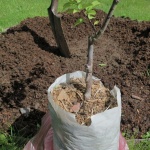
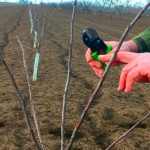
Disease and pest resistance
The hybrid variety stands out for its good resistance to fungus and dangerous insects. In case of infection with moniliosis or clasterosporium, the garden can be saved if protective measures are applied in time. In order for the trees to grow healthy and bear fruit regularly, it is recommended to carry out preventive treatment every season.
The key to the excellent well-being of plants lies in the observance of all agrotechnical conditions:
- cleaning branches and trunk from dead bark;
- treatment of trees with a solution of urea (5%) after harvesting the fruits;
- sanitary pruning;
- removal of diseased and damaged branches;
- processing of sections with preparations containing copper and garden varnish;
- timely use of drugs.

